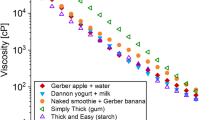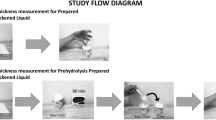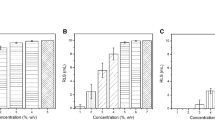Abstract
In Japan, the viscosity of thickened liquids is different among hospitals and nursing homes. In order to standardize viscosity of thickened liquids, the dysphagia diet committee of the Japanese Society of Dysphagia Rehabilitation developed the Japanese Dysphagia Diet 2013 (JDD2013). To decide on a definition of thickened liquids, the committee reviewed categories from other countries. Especially, the criteria of the USA and Australia were used as references. The definition had three levels: mildly thick, moderately thick, and extremely thick. Then a sensory evaluation by health care workers was carried out to decide the viscosity range of each level, and a draft document was made. After collecting public comments, follow-up experiments using thickened water with thickeners using xanthan gum were performed, and the JDD2013 (Thickened Liquid) was determined. The JDD2013 (Thickened Liquid) evaluated the drinking properties, visual properties, and viscosity values of each level. The shear rate of 50 s−1 was adopted to measure the viscosity with a cone and plate type viscometer to duplicate the measurement criteria used by the USA. We also set the values of the JDD2013 with the Line Spread Test to promote the use of guidelines in clinical practice. We believe the JDD2013 standards help hospitals and other settings that care for people with dysphagia to use the same thickness level and the same labels. In the future, the JDD2013 levels will be compared with new international guidelines to help with international understanding of the JDD2013 levels.

Similar content being viewed by others
References
Ministry of Internal affairs and Communications, Statistics Bureau (2016) Population Estimates by Age (5 Year Age Group) and Sex—February 1, 2016 (Final estimates). http://www.stat.go.jp/data/jinsui/pdf/201607.pdf. Accessed 18 Aug 2016.
Ministry of Health, Labour and Welfare (2013) National Health and Nutrition Survey. http://www.mhlw.go.jp/file/04-Houdouhappyou-10904750-Kenkoukyoku-Gantaisakukenkouzoushinka/0000106403.pdf. Accessed 18 Aug 2016.
National Center for Geriatrics and Gerontology (2011) Research report about dysphagia. http://www.ncgg.go.jp/ncgg-kenkyu/documents/roken/cl_hokoku1_23.pdf. Accessed 18 Aug 2016.
The dysphagia diet committee of the Japanese Society of Dysphagia Rehabilitation. The Japanese Dysphagia diet 2013. Jpn J Dysphagia Rehabil. 2013;17:255–67.
National Dysphagia Diet Task Force. National Dysphagia Diet, standardization for optimal care. Chicago, IL: American Dietetic Association; 2002.
Atherton M, Bellis-Smith N, Cichero JAY, Suter M. Texture-modified foods and thickened fluids as used for individuals with dysphagia: Australian standardised labels and definitions. Nutr Diet. 2007;64:53–76. doi:10.1111/j.1747-0080.2007.00153.x.
Wood FW. Psychophysical studies on the consistency of liquid foods. Monogr Rheol Texture Foodst. 1968;27:40–9.
Shama F, Sherman P. Identification of stimuli controlling the sensory evaluation of viscosity. J Texture Stud. 1973;4:111–8. doi:10.1111/j.1745-4603.1973.tb00657.x.
Deto A, Egashira F, Kayashita J. Study of usage of xanthan-gum based commercial thickening agents for rehydration of patients with dysphagia—case of addition to liquid. Jpn J Dysphagia Rehabil. 2008;12:197–206.
Yamagata Y, Izumi A, Egashira F, Miyamoto K, Kayashita J. Determination of a suitable shear rate for thickened liquids easy for the elderly to swallow. Food Sci Technol Res. 2012;18:363–9. doi:10.3136/fstr.18.363.
Uyama R, Fujitani J, Ogoshi H, Kayashita J, Maeda H, Kojo A, Takahashi K, Fujishima I. Classification of thickened liquids by sensory evaluation—establishment of ranges of objective viscosity measurement and line spread test value equivalent to sensory evaluation for thickness. Jpn J Dysphagia Rehabil. 2014;18:13–21.
Mann LL, Wong K. Development of an objective method for assessing viscosity of formulated foods and beverages for the dysphagic diet. J Am Diet Assoc. 1996;96:585–8. doi:10.1016/S0002-8223(96)00160-5.
Nicosia MA, Robbins JA. The usefulness of the line spread test as a measure of liquid consistency. Dysphagia. 2007;22:306–11. doi:10.1007/s00455-007-9086-3.
Saint-Aubert C, Sworn G, Kayashita J. Comparison of two tests used for the classification of food thickeners in the management of dysphagia. Gums Stabilisers Food Ind. 2014;17:359–69. doi:10.1039/9781782621300-00359.
Hadde EK, Cichero JAY, Nicholson TM. Viscosity of thickened fluids that relate to the Australian National Standards. Int J Speech Language Pathol. 2015;18:402–10. doi:10.3109/17549507.2015.1081289.
Cichero JAY, Steele C, Duivestein J, Clave P, Chen J, Kayashita J, Dantas R, Lecko C, Speyer R, Lam P, Murray J. The need for international terminology and definitions for texture-modified foods and thickened liquids used in dysphagia management: foundations of a global initiative. Curr Phys Med Rehabil Rep. 2013;1:280–91. doi:10.1007/s40141-013-0024-z.
Cichero JAY, Lam P, Steele C, Hanson B, Chen J, Dantas RO, Duivestein J, Kayashita J, Lecko C, Murray J, Pillay M, Riquelme L, Stanschus S. Development of international terminology and definitions for texture-modified foods and thickened fluids used in dysphagia management: the IDDSI framework. Dysphagia. 2017;32:293–314. doi:10.1007/s00455-016-9758-y.
Yamagata Y, Kayashita J. Evaluation of the Japanese Dysphagia Diet 2013 by the JSDR dysphagia diet committee (Thickened Liquid) by using several types of thickened liquids. Jpn J Dysphagia Rehabil. 2015;19:109–16.
Author information
Authors and Affiliations
Corresponding author
Ethics declarations
Conflict of interest
The authors declare that they do not have any conflict of interest.
Rights and permissions
About this article
Cite this article
Watanabe, E., Yamagata, Y., Fujitani, J. et al. The Criteria of Thickened Liquid for Dysphagia Management in Japan. Dysphagia 33, 26–32 (2018). https://doi.org/10.1007/s00455-017-9827-x
Received:
Accepted:
Published:
Issue Date:
DOI: https://doi.org/10.1007/s00455-017-9827-x




